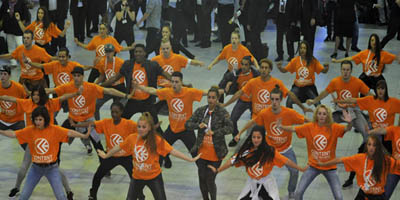
An IBC “flash mob” promoted the launch of the show’s “Content Everywhere” global event series.
AMSTERDAM—Along with the spring NAB Show, Europe’s IBC Show in the fall gives broadcasters and related media companies a chance to launch new products, debate the latest topics and share ideas on future technologies. All those trends were in full view at the five-day 2013 show, which wrapped up in Amsterdam this week.
The show continues to grow; on the final day, IBC executives announced a 3 percent growth in attendance, with approximately 52,322 passing through the doors of the RAI Convention Center by the final day. There were nearly 1,000 exhibitors representing over 150 countries; more than 800 press were registered.
4K WAS EVERYWHERE
Anyone looking for a buzz word at the show had to settle for two characters instead: “4” and “K.” Referred to as a strictly digital cinema format as recently as two years ago, the speed with which the 4K format—which has four times the resolution of current HD standards—has become the dominant focus of the broadcast and production communities has astounded even industry veterans. Fueled by the market introduction of Ultra HDTVs in the past 12 months, the race is on to adopt faster processors and fatter pipes to accommodate the massive size of 4K files.
The next-generation HEVC codec, another important element in the move to 4K, was featured prominently in a number of exhibit booths. Harmonic, in addition to its focus on multiscreen and local ad insertion at the show, stressed the importance of the format in developing what it termed “real-world HD.” The company announced at the show that it has teamed up with Tata Communications, an India-based global telecommunications company to add HEVC support to Tata’s Content Transform cloud-based video transcoding and delivery service, allowing the industry to migrate its existing archives to Ultra HD.

With HEVC/H.265 an emerging format, there are still only a small number of encoders on the market. This has led some vendors to improvise with H.264/AVC, which was used in a live 4K satellite broadcast of a rugby match in London via satellite for an audience of more 400 at the show. The broadcast marked the second live 4K satellite broadcast in as many weeks and also provided a valuable learning experience for both technology providers and producers. It was also designed to showcase the “immersive” quality of 4K.
The match between New Gloucester and Saracens (which Sarecens won), was shown in the Ericsson, Sony and Intelsat booths on a variety of UHD displays, including a JVC seven-foot 4K UHDTV and a Sony 6-meter projection setup. U.K. broadcaster BT sent signals from three Sony F55 4K cameras covering the match, to a vision mixer, which were then sent to Ericsson AVP2000 encoders and RX8200 advance modular receivers. After encoding, the signal was transmitted as a 100 Mbps video from BT’s Global Media Network to Intelsat’s Point of Presence in London, then hopped to the IntelsatOne terrestrial network to Intelsat’s teleport in Germany, where it was uplinked to Intelsat’s Thor6 bird and delivered to a 2.4 m dish on the top of the RAI Convention Center. The result was picture of stunning clarity that stopped booth visitors in their tracks.
“This was a live production and we wanted to do it with technology that would show what the capabilities of 4K are,” said Matthew Goldman, senior vice president of technology for Ericsson. “If you’re going to wow people with something new, why go to 4K if you’re not going to show the immersive technology. It has four times the spatial resolution, twice the temporal resolution and is 10-bit precision.
“When we talk about how beautiful HD is when compared to SD, the experience we had on the floor reminded me of what it felt like when I first saw HD in a production. This [UHD demo] made HD look like SD,” he added.
At the show, officials from Russian broadcaster NTV+ announced their intention to transmit the upcoming Winter Olympic Games in Sochi in 4K to public viewing areas and cinemas and Sony announced at IBC that it intended to deploy its technology to show the 2014 FIFA World Cup in 4K to public venues as well. It’s also widely anticipated that the 2016 Summer Games in Brazil will provide the most widespread 4K coverage of a sporting event yet, and Japan, which is hosting the 2020 Summer Olympics has indicated that state broadcaster NHK will demo those games in 8K. To illustrate its commitment to 8K, NHK demonstrated the format (7680 x 4320) on an 85-inch Sharp LCD, using the MPEG-H HEVC/H-265 format. NHK dubs the format “Super Hi-Vision.”
NEW LEADERSHIP, NEW INITIATIVES
Several new (or nearly) new company leaders announced new initiatives or revealed their strategies for their companies. Charlie Vogt, who recently took the helm at Harris Broadcast, which was created by the sale of Harris’ broadcast division to The Gores Group earlier this year, is a 25-year IT and communications veteran who offered his unique opinion on the broadcast industry, which he described as “fragmented.”
“You look at somebody like Harris Broadcast, we’re the biggest in this space and I look at us as still a small company,” he said. “We’re sort of the ‘gorilla’ among a lot of smaller, fragmented media companies. I think there’s still a lot of consolidation that will continue to occur in this market.” Vogt said he wants to emphasize an almost “start-up” attitude in Harris Broadcast. “I’ve challenged the employees to think of us as a very large, entrepreneurial business opportunity,” he said. “If we can get 1,500 employees that are thinking very entrepreneurial and very ‘start-up like,’ I think the responsiveness for us in our space, which I think our customers are sort of screaming for… the best thing that happened to us was being divested from Harris Corp.”
Avid President Louis Hernandez announced the new Avid Customer Association, a major new initiative to give its customers a larger voice in product development feedback. A Customer Association Executive Committee, which will provide oversight, was announced and includes such industry luminaries as Dr. Andreas Bereczky, executive vice president of technology and production for ZDF German Television and Frank Governale, vice president, CBS News Technology and Operations. The company plans to hold the group's first big event in April of 2014 just prior to NAB.
New product introductions and tech demos included:
Panasonic, which introduced its first P2 HD handheld camera recorder with integrated AVC-Ultra recording and announced that it was prioritizing the development of the 4K VariCam.
Arri announced the Amira, a documentary-style camera based on the company’s CFast 2.0 workflow and an ergonomic design optimized for single-operator use.
Miranda introduced its M3 3Gbps router integration cable that replaces 16 coax cables and connectors by assimilating them into a single, high-density cable structure.
AJA Video previewed its new Io 4K, now updated and customized for Thunderbolt 2 technology and 4K workflows.
The professional video industry's #1 source for news, trends and product and tech information. Sign up below.
Snell announced its Kahuna Maverik, a modular control surface for its Kahuna 360 multiformat production switcher range.
For-A demo-ed a prototype of its 4K Extractor System, an option for its FT-One 4K camera, offering direct control of the camera’s memory.
More information on IBC product introductions can be found here.
Tom has covered the broadcast technology market for the past 25 years, including three years handling member communications for the National Association of Broadcasters followed by a year as editor of Video Technology News and DTV Business executive newsletters for Phillips Publishing. In 1999 he launched digitalbroadcasting.com for internet B2B portal Verticalnet. He is also a charter member of the CTA's Academy of Digital TV Pioneers. Since 2001, he has been editor-in-chief of TV Tech (www.tvtech.com), the leading source of news and information on broadcast and related media technology and is a frequent contributor and moderator to the brand’s Tech Leadership events.

